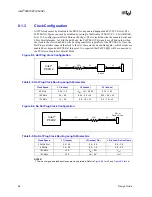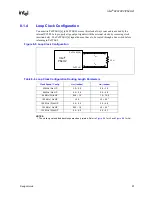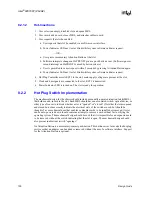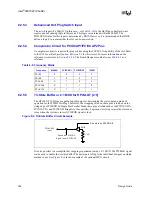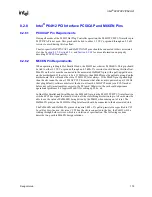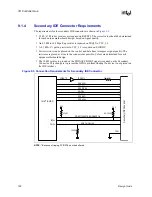
Intel
®
82870P2 (P64H2)
108
Design Guide
8.2.6
Dual Slot Parallel Mode
Dual Slot Parallel Mode is used when it is desirable to have two slots that are Hot Pluggable. No
serialization/deserialization logic is required for this mode of operation.
8.2.6.1
Required Additional Logic
Dual Slot Parallel Mode requires a power switch to be used to turn the slot power on and off. Dual
Slot Parallel Mode also requires the use of a bus and clock switch. Unlike single slot parallel mode,
the PCI signals are not driven to ground whenever a PCI card is to be disconnected. In addition,
Dual Slot Parallel Mode requires auto bus and clock disable logic to immediately disable the PCI
bus and clock when the power fault signal (from the power switch) goes active.
If the platform supports PME# or SMBus connections to the slots, isolation logic is required to
disconnect these signals before inserting or removing a card. See
PCI Hot Plug Specification,
Revision 1.1
for implementation details.
8.2.6.2
Debounced Hot Plug Switch Input
The switch inputs (PA_IRQ[15] and PA_IRQ[10] in this case—see
) to the Hot Plug
controller do not require debouncing logic in this mode. This logic is contained within the P64H2.
8.2.6.3
Comparator Circuit for PCIXCAP1/PCIXCAP2 Pins
A comparator circuit is required for properly decoding the PCI/PCI-X capability of the slot. Refer
to the
PCI Local Bus Specification, Revision 2.2
for this circuit. An example of this circuit is also
contained in the reference schematics. For a frequency reference matrix, see
8.2.6.4
Tri-State Buffer or 2:1 Mux for HPxSLOT [2:0]
As with Single Slot Parallel Mode, the HPxSLOT [2:0] pins are pull-ups/pull downs for
determining the slot count and mode of operation for the P64H2 Hot Plug Controller in Dual Slot
Parallel Mode. The strapping value on these pins is latched on the rising edge of PWROK. In Dual
Slot Parallel Mode these pins also function as the PCIXCAP1A, PCIXCAP2A, and PCIXCAP1B
inputs to the controller. Logic must exist to preserve the slot count value when the system is in reset
(PWROK signal is low). Connecting a tri-state buffer or a 2:1 MUX to these pins to pull the line
high or low accordingly can do this. The PWROK signal can be used to enable the tri-state buffer
to drive the line high or low or select the MUX signal. See
for a tri-state buffer example
for a 2:1 MUX circuit example.
8.2.6.5
HPx_SID Output Signal
In Dual Slot Parallel Mode, this signal is connected to the Amber LED slot status indicator. During
a reset operation, this signal goes high which could flicker the LED on and confuse the user. To
avoid having this LED turn on during a reset operation (PWROK logic zero), it is possible to use a
buffer to electrically isolate this LED from the HPx_SID signal. The PWROK input signal to the
P64H2 should be used to enable this buffer. See the Dual Slot Mode reference schematic in
for an example of this circuit.
8.2.6.6
Pull-Ups/Pull-Downs in Dual Slot Parallel Mode
All PCI signals should follow the
PCI Local Bus Specification, Revision 2.2
pull-up requirements
whether they are muxed or not. Any unused input signals should be pulled to 3.3 V through an
8.2 k
Ω
± 5% resistor to keep them from floating.
Summary of Contents for Xeon
Page 24: ...Introduction 24 Design Guide This page is intentionally left blank ...
Page 30: ...Component Quadrant Layout 30 Design Guide This page is intentionally left blank ...
Page 52: ...Platform Clock Routing Guidelines 52 Design Guide This page is intentionally left blank ...
Page 66: ...System Bus Routing Guidelines 66 Design Guide This page is intentionally left blank ...
Page 118: ...Intel 82870P2 P64H2 118 Design Guide This page is intentionally left blank ...
Page 146: ...I O Controller Hub 146 Design Guide This page is intentionally left blank ...
Page 148: ...Debug Port 148 Design Guide This page is intentionally left blank ...
Page 210: ...Schematic Checklist 210 Design Guide This page is intentionally left blank ...
Page 220: ...Layout Checklist 220 Design Guide This page is intentionally left blank ...
Page 222: ...Schematics 222 Design Guide This page is intentionally left blank ...



